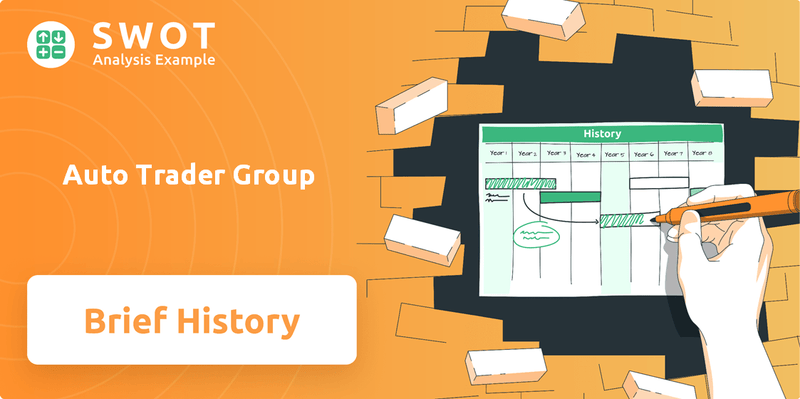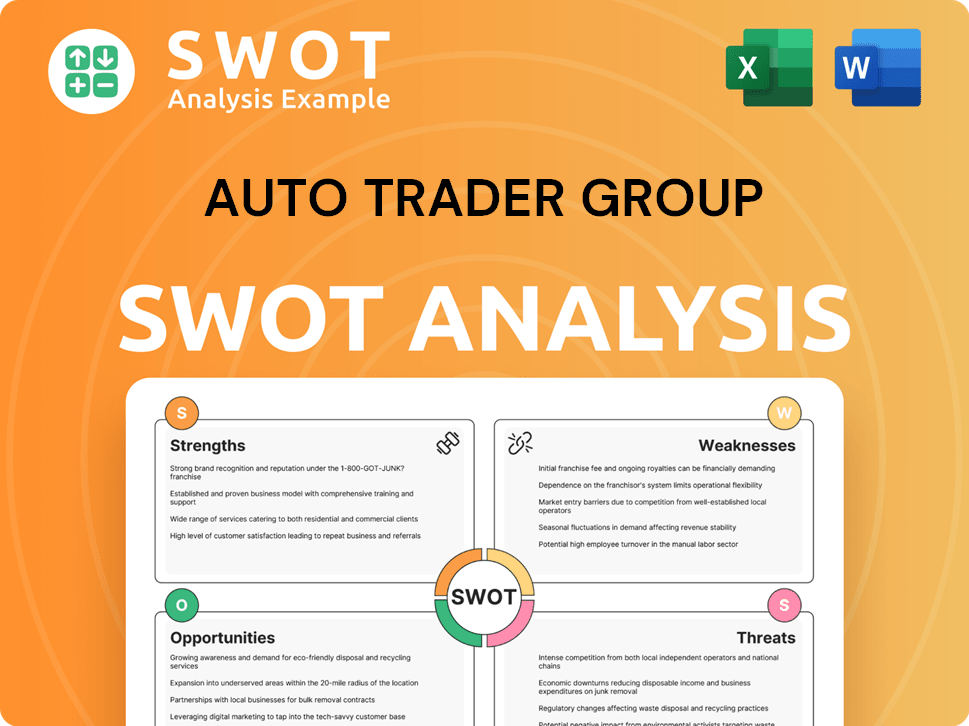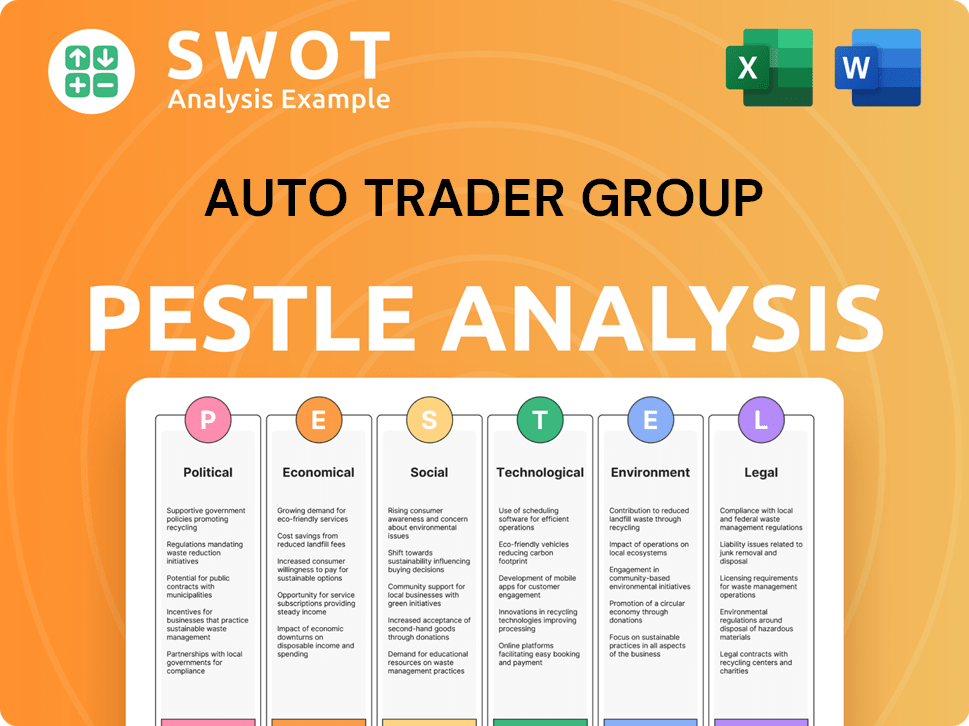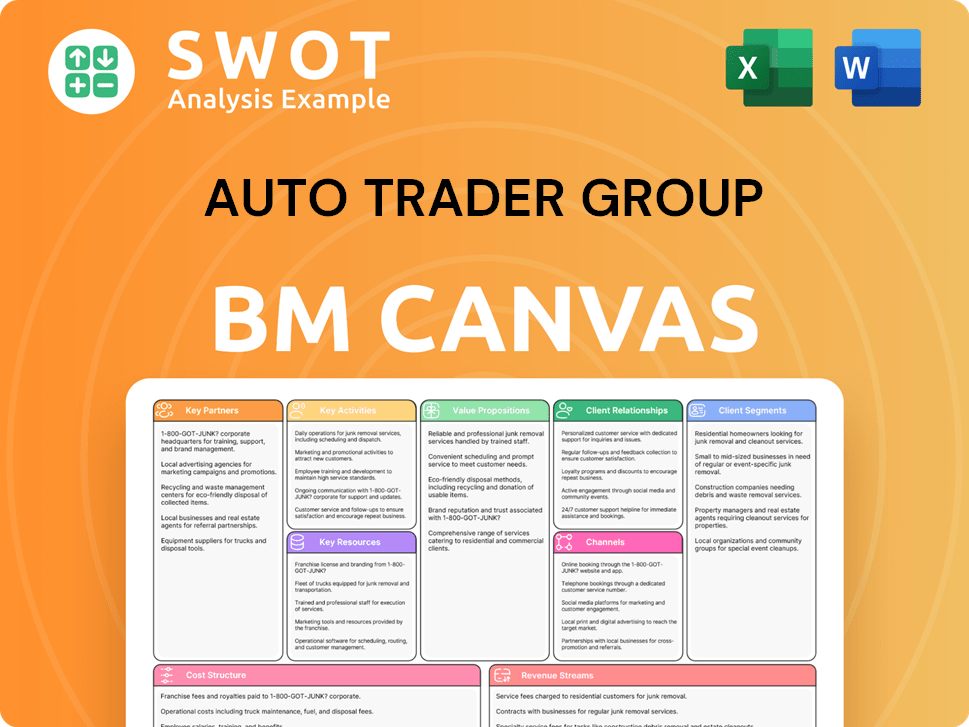Auto Trader Group Bundle
How Did Auto Trader Group Become a UK Automotive Powerhouse?
From its humble beginnings as a regional print magazine in 1977, Auto Trader Group has revolutionized the way vehicles are bought and sold. This Auto Trader Group SWOT Analysis highlights the company’s journey from a classified advertising business to the UK's leading digital automotive marketplace. Explore the fascinating Auto Trader history and discover how a simple idea transformed into a market-dominating force.

This brief history of Auto Trader Group unveils the company's origins, tracing its evolution from a print publication to an Auto Trader online platform. Learn about the key milestones, including the Auto Trader Group IPO date and significant acquisitions, that shaped its success. Discover how Auto Trader UK carved its place in the competitive Auto Trader marketplace and its impressive financial performance, including a 5% increase in group revenue exceeding £600 million for the year ended March 31, 2025.
What is the Auto Trader Group Founding Story?
The story of Auto Trader Group begins in 1977, with the founding of 'Thames Valley Trader' by John Madejski, Paul Gibbons, and Peter Taylor. This marked the genesis of what would become a leading automotive marketplace. Madejski drew inspiration from classified advertising models he observed in the United States, aiming to address the inefficiencies in vehicle sales prevalent at the time.
The core problem they tackled was the fragmented nature of the car market. Finding or selling a vehicle was often a cumbersome process, involving sifting through local advertisements or visiting numerous dealerships. Their vision was to create a centralized, accessible platform for automotive classifieds, revolutionizing how people bought and sold cars.
The initial business model centered around a regional print magazine that listed vehicles for sale. This provided a dedicated space for both individuals and dealerships to advertise their cars, vans, and other vehicles. The early funding likely involved bootstrapping and local investment, given the regional focus. In 1988, the company rebranded to 'Auto Trader', consolidating its various regional magazines under a single, recognizable name. This period was influenced by the growing demand for vehicles and the need for more efficient advertising channels.
The early years of Auto Trader Group were marked by strategic decisions and a focus on building a strong foundation in the automotive market.
- 1977: 'Thames Valley Trader' is founded.
- 1988: The company rebrands to 'Auto Trader', signaling a move towards a unified brand.
- Focus on print magazine advertising, establishing a core business model.
- Early investments and regional focus to build a strong presence.
The evolution of Auto Trader from a print-based classifieds platform to a digital marketplace reflects the changing landscape of the automotive industry. Today, Auto Trader Group is a significant player in the UK automotive market. For a deeper understanding of the company's current operations, including its revenue streams and business model, consider reading Revenue Streams & Business Model of Auto Trader Group.
Auto Trader Group SWOT Analysis
- Complete SWOT Breakdown
- Fully Customizable
- Editable in Excel & Word
- Professional Formatting
- Investor-Ready Format

What Drove the Early Growth of Auto Trader Group?
The early growth of the Auto Trader Group was characterized by the expansion of its print publications across the UK. This expansion, combined with early digital innovations, laid the groundwork for its future success. Key milestones in its history include significant acquisitions and a strategic shift towards a digital-first approach. This transition allowed the company to focus on its online marketplace and adapt to changing consumer behaviors.
By 1995, the print publications of Auto Trader UK covered the entire United Kingdom and were also available in Ireland. This widespread distribution solidified its presence in the market. The print publications were a crucial part of the company's early strategy, establishing a strong brand recognition that would later support its digital transition. The print publications were a key element in the early days of Auto Trader Group.
A pivotal moment was the launch of Autotrader.co.uk in 1996. This move was ahead of its time, preceding the widespread adoption of the internet for commerce. This early digital presence allowed people to buy or sell cars online, demonstrating a forward-thinking approach. This early digital presence was a critical step in the Auto Trader Group evolution.
In July 1998, British international investment firm BC Partners acquired a stake in the business for £260 million. A merger in May 2000, between Guardian Media Group (GMG) and Hurst Publishing, created Trader Media. This merger consolidated operations, streamlining the business and facilitating further growth. This consolidation was a key milestone in the Auto Trader Group acquisition history.
The company embraced digital innovation, launching a mobile website in 2002. From March 2010, it developed dedicated mobile applications for iOS, Android, and Windows Mobile devices. These early mobile offerings included augmented reality features, enhancing the user experience. These innovations helped Auto Trader adapt to the changing market. The Target Market of Auto Trader Group was expanded by these innovations.
Auto Trader Group PESTLE Analysis
- Covers All 6 PESTLE Categories
- No Research Needed – Save Hours of Work
- Built by Experts, Trusted by Consultants
- Instant Download, Ready to Use
- 100% Editable, Fully Customizable

What are the key Milestones in Auto Trader Group history?
The Auto Trader Group has a rich history marked by significant milestones that have shaped its evolution into a leading automotive marketplace. From its early days to its current position, the company has consistently adapted and innovated to meet the changing demands of the automotive industry.
| Year | Milestone |
|---|---|
| 1996 | Launched Autotrader.co.uk, establishing an early presence in the Auto Trader online space. |
| 2013 | Ceased publication of its print magazine, marking a shift towards digital platforms. |
| 2015 | Completed an initial public offering (IPO) on the London Stock Exchange, achieving a market capitalization of approximately £2 billion. |
| 2022 | Acquired Autorama (owner of Vanarama) for an initial consideration of £150 million, with a further £50 million deferred consideration, to expand its leasing offerings. |
| 2024 | Launched 'Co-Driver,' a suite of AI-enabled features to enhance retailer efficiency and improve the car buyer experience. |
| 2025 (March) | Deal Builder product reached approximately 2,000 retailers, up from 1,100 in March 2024, generating approximately 49,000 deals in the year. |
The company has consistently embraced innovation to stay ahead of the competition. A key innovation was the early adoption of digital platforms, including the launch of its website in 1996, which was years ahead of many competitors. Further innovation includes the development of mobile applications with advanced features, such as augmented reality, to enhance the user experience within the Auto Trader UK marketplace.
The early launch of Autotrader.co.uk in 1996 positioned the company as a pioneer in the online automotive classifieds sector. This foresight allowed the company to build a strong digital presence before many competitors.
The company's investment in mobile applications, incorporating features like augmented reality, enhanced the user experience. These features provided innovative ways for consumers to interact with listings and explore vehicles.
The launch of 'Co-Driver' in late 2024, with AI-enabled features, is designed to improve the efficiency of retailers. This innovation helps in creating high-quality adverts and improving the car buyer experience.
The 'Deal Builder' product, enabling car buyers to value part-exchanges, apply for finance, and reserve cars, has scaled significantly. By March 2025, it reached approximately 2,000 retailers, a significant increase from 1,100 in March 2024.
The Auto Trader Group has faced various challenges throughout its history, including adapting to the decline of print media. The company also navigated competitive pressures and market shifts, especially in the new car retail sector. Despite these challenges, the company has demonstrated resilience and adaptability.
The complete cessation of the print magazine in 2013 was a significant challenge. This transition required the company to shift its focus entirely to digital platforms to maintain its market position.
The company has faced competition from other online marketplaces and changing consumer preferences. Auto Trader has had to continually innovate and adapt to remain competitive in the dynamic automotive market.
The challenging new car retail market has presented obstacles for the company. Auto Trader has responded by providing support to its retailer customers, such as offering free advertising during the COVID-19 pandemic.
Auto Trader Group Business Model Canvas
- Complete 9-Block Business Model Canvas
- Effortlessly Communicate Your Business Strategy
- Investor-Ready BMC Format
- 100% Editable and Customizable
- Clear and Structured Layout

What is the Timeline of Key Events for Auto Trader Group?
The Marketing Strategy of Auto Trader Group has evolved significantly since its inception. Here’s a look at the key milestones in the Auto Trader history and its journey to becoming a leading Auto Trader marketplace.
| Year | Key Event |
|---|---|
| 1977 | Founded as 'Thames Valley Trader' by John Madejski, Paul Gibbons, and Peter Taylor. |
| 1988 | Rebranded to 'Auto Trader'. |
| 1995 | Auto Trader magazines expanded across the UK and Ireland. |
| 1996 | Launched its first website, Autotrader.co.uk. |
| 1998 | BC Partners acquired a stake in the business for £260 million. |
| 2000 | Merged with Hurst Publishing to form Trader Media. |
| 2002 | Launched a mobile website. |
| 2010 | Released dedicated mobile applications for iOS, Android, and Windows Mobile. |
| 2013 | Final print edition of Auto Trader magazine published, transitioning to a 100% digital business. |
| 2014 | Apax Partners acquired the business from Guardian Media Group for £600 million. |
| 2015 | Auto Trader Group launched its Initial Public Offering (IPO) on the London Stock Exchange. |
| 2020 | Reported creation of a data lake and intelligence platform. |
| 2022 | Acquired Autorama (Vanarama) for £150 million, expanding into new vehicle leasing. |
| 2022 | Began partnership with the Office for National Statistics to share used car pricing data. |
| 2024 | Introduced its latest Auto Trader Connect module: Trended Valuations and enhanced Retail Check. |
| 2024 | Reported strong growth in revenue and operating profit for H1 FY2025 (April-September 2024). |
| 2024 | Launched 'Co-Driver,' a suite of AI-enabled features. |
| 2025 | Deal Builder scales to approximately 2,000 retailers, generating around 49,000 deals. |
| 2025 | Announced full-year results for the year ended March 31, 2025, with group revenue exceeding £600 million, a 5% increase. |
Auto Trader Group focuses on enhancing the car buying and retailing experience. This involves integrating Deal Builder and expanding AI capabilities with 'Co-Driver'. The company aims to maintain its strong market position and continue delivering value to its customers.
The company anticipates maintaining current operating profit margins and expects an increase due to reduced losses at Autorama. Group revenue for the year ended March 31, 2025, exceeded £600 million, representing a 5% increase. The company is also focused on achieving net zero emissions across its value chain before 2040.
Auto Trader holds a dominant market position, with over 75% of automotive marketplace minutes occurring on its platform. Its competitive lead is more than ten times larger than its nearest competitor. The company's strong market position supports its confidence in future growth.
The company is investing in AI capabilities and further developing the Co-Driver suite to enhance the car retailing and buying experience. The focus is on leveraging data and technology to drive change and improve the automotive market responsibly. New car registration volumes are expected to be well supported over the next two to three years.
Auto Trader Group Porter's Five Forces Analysis
- Covers All 5 Competitive Forces in Detail
- Structured for Consultants, Students, and Founders
- 100% Editable in Microsoft Word & Excel
- Instant Digital Download – Use Immediately
- Compatible with Mac & PC – Fully Unlocked

Related Blogs
- What is Competitive Landscape of Auto Trader Group Company?
- What is Growth Strategy and Future Prospects of Auto Trader Group Company?
- How Does Auto Trader Group Company Work?
- What is Sales and Marketing Strategy of Auto Trader Group Company?
- What is Brief History of Auto Trader Group Company?
- Who Owns Auto Trader Group Company?
- What is Customer Demographics and Target Market of Auto Trader Group Company?
Disclaimer
All information, articles, and product details provided on this website are for general informational and educational purposes only. We do not claim any ownership over, nor do we intend to infringe upon, any trademarks, copyrights, logos, brand names, or other intellectual property mentioned or depicted on this site. Such intellectual property remains the property of its respective owners, and any references here are made solely for identification or informational purposes, without implying any affiliation, endorsement, or partnership.
We make no representations or warranties, express or implied, regarding the accuracy, completeness, or suitability of any content or products presented. Nothing on this website should be construed as legal, tax, investment, financial, medical, or other professional advice. In addition, no part of this site—including articles or product references—constitutes a solicitation, recommendation, endorsement, advertisement, or offer to buy or sell any securities, franchises, or other financial instruments, particularly in jurisdictions where such activity would be unlawful.
All content is of a general nature and may not address the specific circumstances of any individual or entity. It is not a substitute for professional advice or services. Any actions you take based on the information provided here are strictly at your own risk. You accept full responsibility for any decisions or outcomes arising from your use of this website and agree to release us from any liability in connection with your use of, or reliance upon, the content or products found herein.